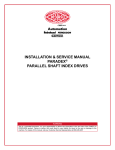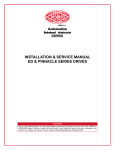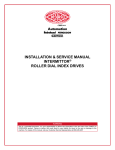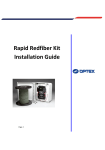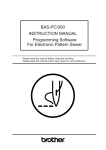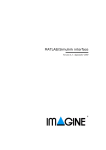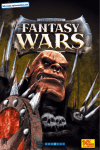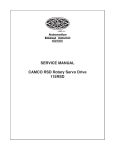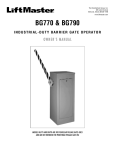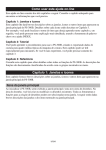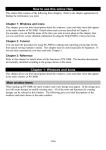Download INSTALLATION & SERVICE MANUAL FD & SENTRY® SERIES
Transcript
INSTALLATION & SERVICE MANUAL FD & SENTRY® SERIES DRIVES WARNING This is a controlled document. It is your responsibility to deliver this information to the end user of the CAMCO or FERGUSON product. Failure to deliver this could result in your liability for injury to the user or damage to the machine. For copies of this manual, call your Customer Service Representative at 800-645-5207 INTRODUCTION INTRODUCTION This manual is supplied to aid in the installation and maintenance of your Ferguson index drive. When contacting Industrial Motion Control, please have the serial number of your unit available. This number can be found on the serial number tag. To determine the model number and the ratio of a Ferguson reducer, refer to the tag which is located on the reducer housing. If the reducer is by another manufacturer, refer to that manufacturer's nametag located on the reducer housing. Unit configurations, reducer mounting positions, and hand of cam nomenclature can be found inside the back cover of this manual. These will aid in describing your unit. Industrial Motion Control provides factory rebuild or repair services at our centrally located Wheeling, Illinois facility. Industrial Motion Control can also provide technicians or engineers for field service calls worldwide. If you have any questions or problems, please feel free to contact our Customer Service Department, or the Technical Sales Department at: 1-800-645-5207 or 1-847-459-5200, FAX: 1-847-459-3064, or EMAIL: [email protected]. If you need to contact a sales representative in your area, you can log on to our web site: www.camcoindex.com and go the section labeled "Find a local Rep" to find the sales office that is nearest to you. At Industrial Motion Control, it is our policy to provide the highest quality products that meet or exceed our customer's requirements. In order to achieve this commitment, Industrial Motion Control has documented its policies and procedures to be in compliance with ISO-9001. Table of Contents Section 1. 2. Page General Information . . . . . . . . . . . . . . . . . . . . . . . . . . . . . . . . . . . . . . . . . . . . . . . .2-4 1.1. Warranty . . . . . . . . . . . . . . . . . . . . . . . . . . . . . . . . . . . . . . . . . . . . . . . . . . . . . .2 1.2. Safety . . . . . . . . . . . . . . . . . . . . . . . . . . . . . . . . . . . . . . . . . . . . . . . . . . . . . .2,3 1.3. Operating Environment . . . . . . . . . . . . . . . . . . . . . . . . . . . . . . . . . . . . . . . . . . .3 1.4. Ordering Replacement Parts . . . . . . . . . . . . . . . . . . . . . . . . . . . . . . . . . . . . . . .3 1.5. Requesting Service . . . . . . . . . . . . . . . . . . . . . . . . . . . . . . . . . . . . . . . . . . . . . .4 1.5. Returning a Unit for Repair . . . . . . . . . . . . . . . . . . . . . . . . . . . . . . . . . . . . . . . .4 Overview . . . . . . . . . . . . . . . . . . . . . . . . . . . . . . . . . . . . . . . . . . . . . . . . . . . . . . . .5-8 2.1. FD Series Location Map & Parts List . . . . . . . . . . . . . . . . . . . . . . . . . . . . . . . . .5 2.2. Sentry Series Location Map & Parts List . . . . . . . . . . . . . . . . . . . . . . . . . . . .6,7 2.3. Ferguson Reducer Location Map & Parts List . . . . . . . . . . . . . . . . . . . . . . . . . .8 3. Specifications . . . . . . . . . . . . . . . . . . . . . . . . . . . . . . . . . . . . . . . . . . . . . . . . . . . . . .9 4. Installation . . . . . . . . . . . . . . . . . . . . . . . . . . . . . . . . . . . . . . . . . . . . . . . . . . . . .10-14 5. Adjustments . . . . . . . . . . . . . . . . . . . . . . . . . . . . . . . . . . . . . . . . . . . . . . . . . . . .13-22 6. 5.1. Sentry Series Internal Clutch . . . . . . . . . . . . . . . . . . . . . . . . . . . . . . . . . . .13,14 5.2. Prox Switch Adjustments . . . . . . . . . . . . . . . . . . . . . . . . . . . . . . . . . . . . . .15,16 5.3. FSC…Ferguson Slip Clutch . . . . . . . . . . . . . . . . . . . . . . . . . . . . . . . . . . . .17-20 Maintenance . . . . . . . . . . . . . . . . . . . . . . . . . . . . . . . . . . . . . . . . . . . . . . . . . . . . . .21 6.1. Using Correct Lubricants . . . . . . . . . . . . . . . . . . . . . . . . . . . . . . . . . . . . . . . . .21 6.2. Changing Oil . . . . . . . . . . . . . . . . . . . . . . . . . . . . . . . . . . . . . . . . . . . . . . . . . .21 7. Troubleshooting . . . . . . . . . . . . . . . . . . . . . . . . . . . . . . . . . . . . . . . . . . . . . . . . .22,23 8. Repair and Replace . . . . . . . . . . . . . . . . . . . . . . . . . . . . . . . . . . . . . . . . . . . . . .24-35 9. Things to Avoid . . . . . . . . . . . . . . . . . . . . . . . . . . . . . . . . . . . . . . . . . . . . . . . . .36,37 REFERENCE: Unit configurations, Reducer Mtg Positions, Hand of Cam Drawing . . . . . .38 1 SECTION 1: General Information Industrial Motion Control (IMC) Index Drives are engineered and manufactured to very high tolerances which necessitate careful inspection and maintenance. Some users of indexing drives have the facilities and trained personnel to accomplish service repair. You must determine the extent to which intricate servicing should be done in your own facility. When in doubt, IMC recommends that IMC trained servicemen make the repairs. 1.1. Warranty - Products are warranted as follows: 1.1.1. Our products are warranted for one (1) year from the date of shipment to be free from defects in workmanship and materials. The foregoing warranty is exclusive and in lieu of all other warranties, whether written or orally expressed or implied and there are no warranties of merchantability or fitness for particular use. 1.1.2. Our obligation under the foregoing is limited to replace free of charge, including the lowest transportation cost, but not including installation or any other charges, any part that our inspection shows to be defective provided that the part was properly installed, suitably maintained and not subject to misuse or abuse, and further provided that the defective parts are returned to our plant within one (1) year after delivery by us. Written permission for such return must first be obtained from IMC. A complete explanation is required of the alleged defects and circumstances. 1.2. Safety – Read and follow all Warnings and Cautions prior to any service or repair. 1.2.1. Roller Gear Drives should not be started and stopped at high speed during the transfer phase of the cam. This can cause serious damage to the Indexer and reduce the cam follower life. For cycling during setup of jog mode, speed must be reduced to 25% of the normal operating speed. The use of an E-stop for purposes other than emergencies is not recommended. A cycle stop button should be incorporated into the system controls. Please consult Industrial Motion Control’s Wheeling factory for additional information. 1.2.2. Always disconnect power and lockout the source before working on these units. 1.2.3. All input and output connections should be backlash free. Use friction lock type shaft couplings such as taper lock bushings, split and clamped hubs, etc., in the input and output drive train. There should be no loose keys, set screws, etc. 2 SECTION 1: General Information (continued) 1.2.4. Reducers should be of minimum backlash variety and directly coupled with a backlash-free connection. If line shafts are used, they must be sized for severe reversing loads. 1.2.5. When using chain or belt drives, incorporate an idler to eliminate any slack. (Do not use spring-loaded idlers.) As the cam motion stops and starts, any slack in the chain changes sides. It is necessary to maintain a constant speed of the input shaft. Loose belts or chains will allow inertial over-run that may cause damage to the cam followers. Belts and chains must be sized for severe reversing loads. 1.2.6. Industrial Motion Control does not provide guarding for other moving parts, such as sprockets, handwheels, switch cams, etc. Numerous pinch points do exist on this equipment and the possibility exists of being struck by a moving part. Since this product is expected to become part of a further developed machine, it is the customer’s responsibility to add safety fencing, guarding, light curtains or other protection devices, as necessary, to protect personnel and property. NOTE: In the event the unit is damaged, contact Industrial Motion Control’s Wheeling factory or your local representative, for proper reconditioning or repair (see sections 1.5 Requesting Service or 1.6 Returning a Unit for Repair). 1.3. Operating Environment – This machine is intended to operate in a clean environment. Excessive coolant, chips, dust, dirt or debris can adversely affect its performance and life. If this machine does operate in a dirty environment periodic cleaning must be practiced and careful inspection of seals and accessories is necessary. 1.3.1. For extended storage, remove vents and fill with proper oil. (Refer to Section 6) 1.4. Ordering Replacement Parts – When ordering parts, always provide the following information: 1.4.1. The serial number shown on the nameplate. 1.4.2. The part name and/or the description listed in the manual. 1.4.3. The part numbers shown on the bill of material or assembly drawings. 3 SECTION 1: General Information (continued) 1.5. Requesting Service – Call our Technical Service Department in Wheeling, IL at 1-800-645-5207 or 847-459-5200 between 8:00AM and 4:00PM CST. When requesting service, always provide the following information: 1.5.1. The serial number shown on the nameplate. (Refer to Inside Front Cover) 1.5.2. A clear description of the problem, including as much detail as possible of the circumstances leading up to the problem. 1.6. Returning a Unit for Repair – Please contact the Repair Department in Wheeling, Illinois at (847) 459-5200 for a "Return Material Authorization" Number (RMA#). The following information is required of a unit for repair, conversion or warranty. 1. Purchase order number 2. Customer name 3. Customer billing address 4. Customer shipping address 5. Person to contact, upon inspection, with delivery and price. 6. Telephone number 7. Model number (located on name plate) 8. Serial number (located on name plate) 9. Description of defects, problems or circumstances. The IMC Repair Department will assess repairs by phone and estimate inspection fees or repair costs. Non-warranty inspection fees will vary depending on the size of the unit and optional equipment mounted. These fees apply only if customer decides not to repair or replace subject unit. Please return IMC equipment only (remove sprockets, pulleys, etc). This will reduce the amount of disassembly time (saving customer cost on labor) and will provide faster evaluation for quoting price and delivery of repair or conversion. The oil must be drained before shipping. Package unit to protect it from weather or damage during shipping. Place the (RMA#) on the outside of the packaging for prompt service. Ship Warranty units via surface freight collect. Ship Non-Warranty units to IMC transportation prepaid. IMC will not accept collect shipments on non-warranty repairs Ship to: 4 Industrial Motion Control, LLC 1444 South Wolf Road Wheeling, Illinois 60090 - USA SECTION 2: Overview The sketches contained in this document are for illustrative purposes only. They are intended to represent standard components and may not be shown to scale. The various models may be different than shown, depending upon options chosen or the particular configuration of a unit. 2.1. FD Series Location Map FIGURE 1 FD Series Parts List 1. 2. 3. 4. 5. 6. 7. 8. 9. 10. Housing Cover Cover shaft Output shaft bearing cap Bearing clamp Shims Shims Open eccentric bushing Eccentric bushing ring Shims 11. 12. 13. 14. 15. 16. 17. 18. 19. Access cover Key Cam Cam spacer ring (not all drives) Roller gear shaft Cam follower Set screw Timken bearing Timken bearing 20. 21. 22. 23. 24. 25. 26. 27. 28. Timken bearing Locknut and washer Oil seal Oil seal Cap screw Cap screw Cap screw Cap screw Cap screw 5 SECTION 2: Overview (continued) 2.2. Sentry Series Location Map FIGURE 2 6 SECTION 2: Overview (continued) Sentry Series Parts List 1. Housing 28. Cap screw 2. Cover 29. Roller gear hub 3. Cover shaft 30. Clutch detent plate 4. Output shaft bearing cap 31. Clutch detent rollers 5. Bearing clamp 32. Roller retainer plate 6. Shims 33. Bearing 7. Shims 34. Thrust washer 8. Open eccentric bushing 35. Bearing adapter ring 9. Eccentric bushing ring 36. Lockwasher 10. Shims 37. Locknut 11. Access cover 38. Cap screw 12. Key 39. Cap screw 13. Cam 40. Pull dowel 14. Cam spacer ring (not all drives) 41. Bearing thrust washer 15. Roller gear shaft 42. Thrust bearing 16. Cam follower 43. Switch plate 17. Set screw 44. Timken bearing 18. Timken bearing 45. Spring 19. Timken bearing 46. Post 20. Timken bearing 47. Compression ring 21. Locknut and washer 48. Compression pin 22. Oil seal 49. Locking nut 23. Oil seal 50. Set screw 24. Cap screw 51. Cap screw 25. Cap screw 52. “O” ring 26. Cap screw 53. Set screw 27. Cap screw 7 SECTION 2: Overview (continued) 2.3. Ferguson Reducer Location Map FIGURE 3 Ferguson Reducer Parts List 1. 2. 3. 4. 5. 6. 7. 8. 9. 8 Housing Ring Gear (& separate spider for some units) Pinion Worm Gear Gear Spacer Key for Indexer Shaft Arrestor Washer Lockwasher Cap Screw - deleted "keeper" Cap Screw for Clamping Hub 10. 11. 12. 13. 14. 15. 16. 17. 18. 19. Closed End Cap Cap Screws Shim Pack Timken Bearing Open End Cap Oil Seal Wear Sleeve Cover Plate Cap Screws Oil Plugs External Output Shaft Torque Limiter Input Shaft Overload – Available on Ferguson R Series Reducers Only Lubrication Capacity 4 Main Oil Sump (Gallons) Lubrication Capacity Gear Reducer 4 Unit Weight (LBS) Unit Weight with Reducer (LBS) Unit Weight with Motor/Reducer Pkg. (LBS) YES RT3 N/A 7 OZ. N/A 10 N/A 25 162 20CDSF N/A MDB625 (.5) .5 HP YES RT5 N/A 0.5 13 OZ 50 N/A 110 200 26CDSF N/A MDB625 (.5) .5 HP YES RT5 N/A 1.00 32 OZ 115 170 200 250 30CDSF R3 MDB625 (1) 1 HP YES RT6 R3FSC 1.75 48 OZ 125 195 225 300 6SFM R3 MDB875 (1.5) With 1.5 HP 1.52 HP YES RT6 Or R3FSC DTL10 2.50 2 QTS 300 395 445 451 R400 C/F MDB875 (2) 1.52 HP N/A N/A R4FSC 3.00 1.5 GAL 560 635 686 501 R500 C/F MDB1125 (3) C/F N/A N/A R5FSC 5.50 2.5 GAL 900 1035 1255 Standard Reducer Optional Reducer Standard AC Motor With Air Clutch/Brake Bison Gear Motor N/A N/A 3 Model FD, S & SM 100 3 Sentry Series Internal Torque Limiter 828 (.25) HP 1 Standard 90 V DC Motor 3 SECTION 3: Specifications # CHART 1 Requires “C” face reducer. 180 V.DC. 3 Weights are approximate, less crating. 4 Refer to section on lubrication for specifications of lubricants. Amounts are approximate only for standard HM-1 position. Actual capacities may vary by other mounting positions or drive codes. Always check oil level site glass or plugs before topping off or refilling. 1 2 9 SECTION 4: Installation These units are manufactured to meet a specific set of design parameters. Any change to the load on the output shaft, or speed of the camshaft may require a size change. No change can be made without affecting other performance characteristics of the unit and, therefore, should not be done without consulting the factory. 4.1. To install the unit: 4.1.1. Rotate camshaft so cam is in center of dwell (see figure 4). FIGURE 4 4.1.2. Mount the Indexer into position on a rigid base and secure with the proper size fastener. 4.1.3. Align the Indexer with respect to the station positions before tightening fasteners. Use a dial indicator or other appropriate tools to insure alignment. 4.1.4. Tighten all mounting bolts securely and uniformly. 10 SECTION 4: Installation (continued) 4.1.5. Check the oil level of the sump and gear reducer prior to operating the unit. 4.1.6. Pay particular attention if the oil level is too high. If a unit has been idle for some time since its manufacture, condensation may be present. If condensation is noticed, the oil should be drained, the unit thoroughly cleaned and re-filled with oil (see Chart 1 in Section 3 for capacities). NOTE: If shot pins or guide pins in dies are used, the unit should have been manufactured with a dwell relief in the cam. Tangential loads may require the use of a shot pin or dial clamp. If vertical loads exist, an anvil may be required. For further information, consult your local Industrial Motion Control Representative or the Technical Service Department at 1-800-645-5207 or 847-459-5200. 4.1.7. The indexing unit must be filled with SAE 90 EP Gear oil or equivalent meeting MIL-PRF-2105E and API Service Classification GL5 or GL6 before operation (see Chart 1 in Section 3 for capacities). An example of this oil is Mobilube HD 80W-90. For extreme applications, use Mobilube HD 85W-140 (consult your local representative to determine if your application is extreme). 4.1.8. Bronze Gear Reducer oil must be SAE140 Steam Cylinder Oil meeting AGMA #8 Compound, MIL SPEC, MIL-L-15016A; symbol 3150 (see Chart 1 in Section 3 for capacities). (Or manufacturer’s specified oil if not a Industrial Motion Control manufactured reducer.) 4.1.9. Be sure optional controller is properly fused – refer to vendor’s manual, which is included under separate cover for information on installation, set up, adjustment and maintenance. 4.1.10. Check the adjustment of the Switch cam if your unit has this option. To insure unit stops in dwell, see Figure 4. 4.1.10.1. A standard FD indexer is shown in figure 4 with a Brake Cam & Limit Switch shown with the keyway in the center of the dwell period. It is necessary to phase the Brake Cam such that the input shaft of the indexer stops during the dwell period of the index cycle while leaving enough of the dwell period for the input shaft to accelerate to full speed before leaving the dwell period. 11 SECTION 4: Installation (continued) 4.1.10.2. If the indexer has a drive code which causes multiple indexes per camshaft revolution (i.e. X2, X3, etc… drive codes), additional lobe(s) on the Brake Cam are required. The lobes will be equally spaced. Therefore, phasing the one lobe of the Brake Cam to one dwell period on the indexing cam will, in most cases, cause the other lobes to be correctly phased with the other dwell periods. NOTE: Controllers are normally shipped loose and brake cam / limit switches are mounted to the unit. However, neither are set or adjusted at the factory. Controller must be set for load & speed of the application per instruction in the vendor’s manual. The limit switch and brake cam must be set so as to initiate the stopping cycle and result in an on station stop (somewhere in the cam’s dwell period). NOTE: The switch and brake cam commonly provided to initiate the stop cycle can not be used to indicate “on station.” A second switch and brake cam should be ordered for this purpose. 12 SECTION 5: Adjustments The FD & Sentry Drives are solid mechanical, backlash-free mechanisms. There are no adjustments required on the Indexer during installation unless it is furnished with a torque limiting device or a motor drive package equipped with speed control. After the Indexer has been installed and set up with the user’s load in place, it will be necessary to check these items for proper adjustment and settings. NOTE: The drive should be in the center of dwell and dowel pinned to the base before installing accessories, as previously mentioned in 4.1.1. & 4.1.5.4. 5.1. Internal Torque Limiters (‘S’ Series only) 5.1.1. S/SM100 FIGURE 5 Industrial Motion Control’s S/SM100 is the same as the previously offered FD100 with the internal clutch. That means that this unit has a non-adjustable internal clutch. Also, this unit, unlike the other Sentry units, has a junction box on the unit to mount the proximity switch. 13 SECTION 5: Adjustments (continued) 5.1.2. S/SM162 - S/SM300A FIGURE 6 Industrial Motion Control’s S/SM162 - S/SM300A has an adjustable internal clutch. The torque setting is adjusted by tightening 3 or 4 (depending upon unit size) independent screws (clockwise rotation increases the torque setting). The screws should be run all the way in, then adjusted equivalent amounts (in 1/4-turn increments) from that point. The adjusting screws are retained and sealed by a vibration resistant thread coating. This coating could, over a number of adjustments, wear out. Reapplication of this coating will return screws to manufacturers specifications. 14 SECTION 5: Adjustments (continued) 5.2. Prox Switch Adjustments 12 Volt D.C. Power Supply FIGURE 7 5.2.1. Internal Clutch Trip Detection Prox Switch 5.2.1.1. Screw the prox switch into the unit until its face just touches the detection plate (the angular surface visible through the prox switch hole). The L.E.D. on the end of the switch should now be lit. 5.2.1.2. Screw the prox switch out until the L.E.D. goes out. Next, screw the switch in again until the L.E.D. lights, and then turn approximately 1/4 turn more. Rotate the output shaft a full revolution, the L.E.D. should always remain on. Be sure the end of the prox switch does not contact the detection plate. 15 SECTION 5: Adjustments (continued) 5.2.1.3. Trip the internal clutch, the L.E.D. should now go off. Repeat this process several times making a full revolution of the output, the L.E.D. must go off consistently when the clutch is tripped and light when the clutch is reset. NOTE: The detection switch set up procedure is appropriate for the Industrial Motion Control (IMC) part numbers listed below. If your equipment has another model number or is from another manufacturer, contact the switch manufacturer for set up procedures. IMC Part Number 1000000938 (Turck # Bi 1-G08-AN6X) IMC Part Number 1000000939 (Turck # Bi 2-G12-AN6X) IMC Part Number 1000003115 (Turck # Bi 1-G08-AN6X-H1341) 16 SECTION 5: Adjustments (continued) 5.3. FSC… Ferguson Slip Clutch Location Map 1. Housing 3. Body & Cone 4. Thrust Bearing 5. Silicon Spring 6. Adjusting Nut 7. Guide Pin 8. Spool 9. Ball Plunger 10. Liner Bushing 11. Setscrew 12. Pipe Plug FIGURE 8 17 SECTION 5: Adjustments (continued) 5.3.1. Clutch Adjustment Description The clutch must be adjusted to prevent any slippage during normal operation to prevent shock loading. It should also not be adjusted so tight as to be able to damage the indexer during a jam or overload. However, it is best to err on the side of being tighter than required. The proper setting for the clutch is determined by gradually tightening the clutch adjusting nut until the clutch no longer slips in either direction during a complete, fully loaded index cycle at normal speed. 5.3.2. Shut-off Spool Use & Adjustment The shut-off spool (number 8, Figure 9) is attached to body and cone (number 3, Figure 8) by means of shallow round threads in body and cone (number 3, Figure 8) and a ball plunger (number 9, Figure 8) in spool (number 8, Figure 8). When the clutch is operating normally (i.e. not slipping), there is no relative movement between spool (number 8, Figure 8) and main body (number 3, Figure 8) and the remainder of the clutch, including the spool (number 8, Figure 8) driven by pin (number 7, Figure 8). This relative rotation causes the spool to move along the screw threads on the body (number 3, Figure 8). The spool will move to the left or to the right, depending on the rotation of the clutch. This lateral movement of the spool is intended to activate a limit switch arm located in the center groove in the spool. The "tripped" limit switch should be electrically connected to the controls to stop the operation of the motor driving the indexer. 5.3.3. Resetting Procedure To recover from a jam or overload in which the clutch has slipped sufficiently to displace the shut-off spool: Manually disconnect the power to the drive motor to prevent an accidental start-up (use O.S.H.A. approved lockout procedures), clear the cause for the overload. Then simply push or pull the spool (number 8, Figure 8) on the main body (number 3, Figure 8) to the thread engagement closest to the center position on the threaded portion of the body (number 3, Figure 8). Check the limit switch circuitry for proper operating conditions. The indexer can now be powered up and production resumed. 18 SECTION 5: Adjustments (continued) 5.3.4. Clutch Adjustment Procedure CAUTION: OPERATIING THE INDEXER WITH THE CLUTCH NOT ADJUSTED CAN CAUSE IMMEDIATE AND SEVERE DAMAGE TO THE INTERNAL COMPONENTS OF THE INDEXER. a. b. Loosen cone point setscrew (number 11, Figure 8). Insert pins of spanner (Figure 9) into holes of adjusting nut (number 6, Figure 8), and turn nut clockwise one notch in the adjusting nut. This will tighten the clutch. NOTE: For heavy indexing loads or clutches on large units, it may be necessary to increase the length of the spanner wrench to gain more leverage. FIGURE 9 If clutch has not been adjusted for a long period of time, it may be necessary to turn the nut counter-clockwise several turns, and tap the face of housing (number 1, Figure 8) towards the indexer with a rubber mallet to separate (loosen) the tapers. Take note of the number of loosening turns so the adjusting nut can be re-tightened to its original position. c. Re-tighten setscrew (number 11, Figure 8) making sure it engages in adjusting nut (number 6, Figure 8) to prevent damage to screw threads. NOTE: If setscrew (number 11, Figure 8) is accidentally tightened on threaded portion of adjusting nut (number 6, Figure 8), it will raise a burr. Failure to remove this burr will cause shearing of threads and jamming of nut of housing (number 1, Figure 8). To remove burr, remove setscrew (number 11, Figure 8) and rotate adjusting nut counter-clockwise until burr is in center of tapped hole in housing (number 1, Figure 8). Use a hand electric drill that fits freely into the tapped hole. Drill into the adjusting nut (number 6, Figure 8) sufficiently to remove the burr. There are (2) setscrews (number 11, Figure 8). They are positioned so one screw is half way between the slots in the nut when the other screw engages the slot in the nut. This is to allow for fine adjustment of the clutch. DO NOT use both screws at the same time as one screw will not be over a slot and will cause damage to the screw threads. 19 SECTION 5: Adjustments (continued) d. Apply power to the unit and check for clutch slippage. NOTE: When clutch is not slipping, entire clutch will rotate as a single unit. When clutch is slipping body and cone (number 3, Figure 8) will not rotate with the other parts of the clutch. Small amounts of clutch slippage can be difficult to determine. To aid in providing if the clutch is slipping, use a grease pencil or felt tip marker and draw a line across face of nut (number 6, Figure 8) and along body and cone (number 3, Figure 8). If clutch is slipping, the line on nut (number 6, Figure 8) and body and cone (number 3, Figure 8) will move relative to each other. DO NOT LET CLUTCH SLIP ANY LONGER THAN NECESSARY OR CLUTCH MAY HEAT UP RESULTING IN UNPREDICTABLE OPERATION AFTER IT COOLS. e. Repeat steps a through d until there is positively no clutch slippage. 5.3.5. Lubrication: a. Clutches are grease packed at the factory and should not require additional lubrication. If clutch is subject to consistent slippage and heating, remove pipe plug (number 9, Figure 8) and insert your standard grease fitting, lubricate with Lithium EP grease. Do not use air pressure gun! 20 SECTION 6: Maintenance 6.1. Correct Lubricants – For the protection of the unit use only lubricants meeting the specifications shown below in Chart 2. If you have any questions about a particular lubricant feel free to call us at 1-800-645-5207 or 847-459-5200. 6.2. Changing Oil 6.2.1. All parts are oil splash lubricated except for isolated areas where grease fittings will be supplied. 6.2.2. Maintain oil to the midpoint of the sight gauge or oil level & fill plug. NOTE: The orientation of your unit will determine the exact quantity of oil required. 6.2.3. Drain, flush and fill the unit in intervals of 2400 hours or at least yearly. If drive operates at speeds above 300 RPM or at temperatures above 140 degrees F., increase oil change frequency to 6 months or 1200-hour intervals. NOTE: When draining the oil observe for metal particles. This is an indication of excessive wear and the source of this wear must be determined. 6.2.4. Service all grease fittings on 1-month intervals or every 200 hours of operation. NOTE: In the majority of the applications, grease fittings are not supplied since oil splash supplies the lubrication. Should grease be specified use Lithium No.2. Indexer Oil: Use SAE 90 EP Gear oil or equivalent meeting MIL-PRF-2105E and API Service Classification GL5 or GL6. For example, Mobilube HD 80W-90 Capacity: See specifications in Chart 1 for your model. Gear Oil: Bronze Gear Reducer oil requires SAE 140 Steam Cylinder Oil, meeting AGMA #8 Compound, MIL SPEC. MIL-L-15016A; symbol 3150 (Or manufacturer’s specified oil if not a Industrial Motion Control manufactured reducer.) Capacity: See specifications in Chart 1 for your model. CHART 2 21 SECTION 7: Troubleshooting TROUBLESHOOTING GUIDE Symptom Solution Backlash at output shaft (in dwell) Worn/damaged followers Replace Tight Stations (torque required to rotate cam shaft through tight station is more than 1 1/2 times the loose station) Bent cam followers Replace; inspect holes in roller gear shaft Pitting of cam follower outer race/cam track surface Incorrect oil Replace cam followers and fill unit with correct oil Fine magnetic metallic particles in oil; appear bronze color when in oil Steel and iron worn from bearing roller ends and cages and cams surface (this is a normal condition) Normal-Flush out when replacing oil A. End play in worm shaft due to improper pre-load of shaft bearings. Contact Technical Services at 800-645-5207 or 847-459-5200. B. Loose gear on camshaft. Contact Technical Services at 800-645-5207 or 847-459-5200. A. Improper pre-load on worm-shaft bearings. Contact Technical Services at 800-645-5207 or 847-459-5200. B. Incorrect alignment of worm and gear. Contact Technical Services at 800-645-5207 or 847-459-5200. C. Excessive worm speed. Contact Technical Services at 800-645-5207 or 847-459-5200. REDUCER: Excessive Backlash Overheating in Excess of 210°F 22 Cause SECTION 7: Troubleshooting (continued) TROUBLESHOOTING GUIDE Symptom OIL LEAKS AT: Seals Cause Solution Worn or damaged seal and/or shaft surface Replace seal; polish shaft Shims Damaged shim Replace; apply “Loctite Aviation Grade Sealant” to both sides Cap Screws Shim damaged between screw Replace gasket or shim; apply hole and interior of housing “Loctite Aviation Grade Sealant” to both sides Holes drilled through Remove screw, apply “Loctite Threadlocker” and re-install Cover joints Inadequate sealant Remove, clean and reassemble with silicone rubber sealant Oil service pipe fittings Not properly sealed Remove, clean and reinstall with “Loctite Teflon Pipe Sealant” NOTE: In the event that damage is found, it is recommended that the unit be returned to the factory for repair or that an Industrial Motion Control Serviceman make or supervise repairs in your plant. Proper alignment and adjustment of the components are essential to their performance and life. 23 SECTION 8: Repair and Replace 8.1 Cam Follower Replacement – Models 162, 200, 250, 451, & 501. 8.1.1. Rotate camshaft to mid-dwell position. (See Figure 4) 8.1.2. Drain oil & remove rear access cover plate. 8.1.3. Remove cap screws from output shaft bearing cap and remove bearing retaining cap. Save all of the shims for re-assembly. 8.1.4. Remove output shaft from housing by driving from rear with a soft mallet. 8.1.5. Remove outer Timken bearing race from bearing cap and save for re-assembly. 8.1.6. Determine the type of cam follower from the following diagrams and replace using the procedure in the diagram. 8.1.7. Replace output shaft back into the housing and drive outer race of front bearing into the housing until it seats against rollers of inner race. 8.1.8. Assemble bearing cap to housing with all of the original shims (or a new set with the same thickness). Tighten all cap screws. 8.1.9. Scrape old sealant from housing and rear access cover. Apply new silicone rubber sealant and assemble rear access cover to housing. Tighten all screws evenly. 8.1.10. Refill with oil to level indicated. 8.2. Cam Follower Replacement – Model FD300 8.2.1. Drain oil and remove top access cover. 8.2.2. Rotate camshaft so cam follower is directly below access opening. 8.2.3. Determine the type of cam follower from the following diagrams and replace using the procedure in the diagram. 8.2.4. Scrape old sealant from access cover and housing. 8.2.5. Apply new silicone rubber sealant and assemble top access cover to housing. Tighten all screws evenly 8.2.6. Refill with oil to level indicated 24 SECTION 8: Repair and Replace (continued) 8.3. Cam Follower Replacement – Model FD100 8.3.1. Rotate camshaft to mid-dwell position. (See Figure 4) 8.3.2. Drain by removing pipe plug in housing. 8.3.3. Remove cap screws from output shaft bearing cap and remove cap. Keep all shims for re-assembly. 8.3.4. Pull output shaft from housing. 8.3.5. Determine the type of cam follower from the following diagrams, and replace using the procedure in the diagram. 8.3.6. Replace the output shaft back into housing, and drive outer race of front bearing into housing until it touches rollers of inner race. 8.3.7. Assemble bearing cap to housing with all of the original shims (or a new set with same thickness). Tighten all cap screws evenly to pre-load bearing. NOTE: Use Permatex Aviation Form-a-Gasket #80019 between the housing and the first shim of the output shaft bearing ring. NOTE: Use Locktite Threadlocker #222 on cap screws. 8.3.8. Refill oil sump with 7 oz. of Mobilgear SHC-680 through oil level plug. Use Locktite #592 Teflon Pipe Sealant on pipe plug. 25 SECTION 8: Repair and Replace (continued) FOLLOWER NO. FM-50; FM-62; FM-75 FIGURE 10 DISASSEMBLY: Remove jam nut, setscrew, follower and nylon plug. ASSEMBLY: Clean the follower stud hole in the hub and inspect for an out-of-round condition, which could cause backlash by failing to support the stud at the top. Apply a light coat of assembly grease to a new cam follower and install it firmly against seat; loosen and retighten. Install new nylon plug and tighten setscrew and jam nut in place. 26 SECTION 8: Repair and Replace (continued) FOLLOWER NO. FM-100 & FS100 - FS400 FIGURE 11 DISASSEMBLY: Remove locknut, setscrew and follower. ASSEMBLY: Clean the follower and stud hole in the roller gear hub and inspect for elongation, which could cause backlash by failing to support the stud at the top. Apply a light coat of assembly grease to a new cam follower and install it firmly against seat; loosen and retighten. Install setscrew, tighten sufficiently to mark follower stud with setscrew point and remove setscrew. Remove cam follower and drill a setscrew seat at the marked position deeply enough to make seat diameter equal to setscrew diameter. Clean cam follower, coat with grease and install firmly against seat; check that the drilled seat lines up with the setscrew hole. Assemble setscrew and locknut and tighten firmly. 27 SECTION 8: Repair and Replace (continued) FOLLOWER NO. F-50 THROUGH F-400 FIGURE 12 DISASSEMBLY: Remove setscrew and pull cam follower from hole using a draw hammer secured in tapped hole. ASSEMBLY: Clean the follower stud hole in the roller gear hub and inspect for elongation, which could cause backlash by failing to support the stud at the top. Place a socket head screw in pull hole and strike its head - do not strike the follower end cap when installing. Apply a light coat of assembly grease to a new cam follower, orient so the setscrew and seat are in line and install lightly against shoulder. Place a drop of No. 222 grade Loctite® on setscrew, install and tighten firmly. 28 SECTION 8: Repair and Replace (continued) FOLLOWER NO. F-38 FIGURE 13 DISASSEMBLY: Refer to Figure 12. (Note - there is no draw hammer hole.) ASSEMBLY: Refer to Figure 12, except: F-38 has no shoulder. Use feeler gauge to set .005 clearance under washer. 29 SECTION 8: Repair and Replace (continued) 8.4. Oil Seal Replacement 8.4.1. Remove oil seals by drilling a number of holes into the seal case. The seal may then be removed with a pointed tool. Be sure to remove all metallic chips created during the drilling of removal holes. 8.4.2. Check dimensions – to be sure that shaft and bore diameters match those specified for the seal selected. 8.4.3. Check seal – for damage that may have occurred prior to installation. A sealing lip that is turned back, cut or otherwise damaged should be replaced. 8.4.4. Check bore – to see that the leading edge is deburred, A rounded corner or chamfer should be provided. 8.4.5. Check shaft – remove surface nicks, burrs and grooves and look for spiral machine marks that can damage the seal lip. 8.4.6. Check shaft end – remove burrs or sharp edges. The shaft end should be chamfered. 8.4.7. Check splines and keyways – smooth any sharp edges and when necessary protect the seal lip with an assembly sleeve or shim stock. Round the edges of the spline or keyway as much as possible and lubricate with a hard, fibrous grease. 8.4.8. Check seal direction – make sure that the new seal faces in the same direction as the original. Generally, the lip faces the lubricant or fluid to be sealed. 8.4.9. Pre-lubricate the sealing element before installation by wiping with lubricant being retained. 8.4.10. Use the correct installation tool – press fitting tools should have an outside diameter .010” smaller than the bore size. If possible, the center of tool should be relieved so that pressure is applied only at the O.D. 30 SECTION 8: Repair and Replace (continued) 8.4.11. Use proper driving force – where possible, an arbor press; otherwise, a dead blow hammer to avoid popping the spring out of the seal. NEVER HAMMER DIRECTLY ON THE SURFACE OF THE SEAL. 8.4.12. Bottom out the tool or seal – to avoid cocking of the seal in the bore. This also positions the seal correctly on the shaft. 8.4.13. Check for parts interference – from other machine parts that might rub against the seal causing friction and damaging heat. 8.5. Reducers Typical Ferguson “R” Series Reducer FIGURE 14 31 SECTION 8: Repair and Replace (continued) 8.5.1. “R” Series (Ferguson) Reducers NOTE: The “R” Series reducer is a double enveloping worm gear type with components manufactured to Industrial Motion Control’s specifications by selected vendors. The worm and gear are provided in matched sets with minimal backlash and installed in housings of Industrial Motion Control’s design. The identifying number of a reducer consists of the letter “R” followed by a number and a two-digit number (i.e. R4 15). The “4” indicates the center-tocenter distance between the worm and the gear; the “15” reflects the reduction ratio. In this example, the ratio is 15:1. 8.5.1.1. Component Removal 8.5.1.1.1. Worm Shaft. 8.5.1.1.1.1. Drain oil and remove cover plate. 8.5.1.1.1.2. Record the distance between the worm bearing shoulder on the splined end of the shaft (opposite the single extension end of the shaft) to the finished bore on the cover side (see Figure 15). 8.5.1.1.1.3. Remove screws and worm bearing caps, keeping each set of shims with their respective bearing caps. 8.5.1.1.1.4. Tap the worm shaft back and forth axially to move the outer race of the supporting bearings out of position. 8.5.1.1.1.5. Shaft the worm to the side of the housing, clear of the gear. Remove the worm through the bearing bore in the housing. 32 SECTION 8: Repair and Replace (continued) NOTE: Worm must be dropped before attempting to remove the gear. 8.5.1.1.2. Gear 8.5.1.1.2.1. Remove the worm as described above. 8.5.1.1.2.2. Record the distance from the finished face of the housing to the unmarked face of the gear (see Figure 15). 8.5.1.1.2.3. Remove screw and washer retaining gear, if applicable. 8.5.1.1.2.4. Loosen the screw clamp on the split hub side of the gear. 8.5.1.1.2.5. Remove the gear. Tapped holes in the end of the gear hub may be utilized in conjunction with a puller. 8.5.1.1.3. Component Replacement NOTE: If both worm and gear were removed from the housing, the gear must be replaced before the worm shaft is installed 8.5.1.1.3.1. The correct relationship of the worm and gear must be maintained when reassembling the components. Regardless of the actual position of the reducer unit on the roller gear drive or Intermittor housing, you must imagine that the worm is over the gear and that you are viewing the worm from the single extension end (the end opposite of the splines on the worm shaft) with the unmarked face of the gear to your right. Maintain this relationship between components when installing the gear on the roller gear camshaft. 33 SECTION 8: Repair and Replace (continued) 8.5.1.1.3.2. The distance from the finished face of the housing to the unmarked face of the gear, noted at the time of disassembly, must be duplicated, either by grinding the adjusting spacer or adding shims (see Figure 15). 8.5.1.1.3.3. Tighten the clamp screw in the split hub of the gear and assemble the gear retaining screw and washer, if such were provided as part of the factory installation. 8.5.1.1.3.4. Press cones of the tapered bearings onto the worm shaft and insert the worm shaft in the housing. 8.5.1.1.3.5. Assemble bearing cups, shims and caps and establish preload, 2 IN-LBS .003 SHIM. Adjust shims under bearing cups until the dimension between the worm bearing shoulder and the finished housing bore, as recorded at the time of disassembly, is duplicated (see Figure 15). NOTE: Do not discard any of the shims. Make adjustments in pre-load by shifting shims from one bearing cup to the other. 8.5.1.1.3.6. Replace cover plate and refill with oil. Refer to Chart 1 & 3 for quantity and specification. 34 SECTION 8: Repair and Replace (continued) 8.5.2. Winsmith Worm Gear Reducer NOTE: Due to its modular and hollow shaft design, it is not considered economical to replace components only in these reducers. Except for seal or other oil leak problems, replacement of entire reducer is recommended. 8.5.3. Brison Gear Motor NOTE: May come with 1/11 HP or 1/4 HP motor depending on reducer ratio. It is not considered economical to repair or replace components only. Replacement of the entire product is recommended. 35 SECTION 9: THINGS TO AVOID An Industrial Motion Control Indexer is a relatively simple mechanism using an input shaft mounted cam to drive roller followers on the output hub. While simple in concept, the precision nature of the indexer requires that it must be used within design constraints. The indexer is, after all, just a mechanical device. In this regard there are several situations which should be avoided to protect your warranty and maximize indexer life. Off-center loading, such as might be seen when a large press is used in conjunction with an indexer, requires a back-up support anvil under the dial. The bearings of an indexer are very heavy duty, but their life will be shortened dramatically by unsupported, asymmetrical loading. The support anvil is typically designed with .001” of clearance under the dial and is strong enough to carry the full load of the asymmetrical load. Consult the IMC Department at 1-800-645-5207 or 847-459-5200 for assistance in all asymmetrical load situations. E-Stop Usage should be limited to emergency situations only. E-Stops should not be used to jog an indexer. The E-Stop function causes extreme load conditions inside the indexer by virtue of the instantaneous stopping of significant weights. This is not unlike driving a car into a brick wall. Excessive use of the E-Stop will significantly shorten the life of the indexer. Starting and Stopping while in the motion profile of the cam will also put high loading on the indexer’s internal components. Should it be necessary to stop/start the indexer in any position other than the dwell of the cam, it is best to reduce motor speed to avoid overloading the unit. Shock Loading may also lead to problems. Shock loading typically occurs when there is looseness in the input drive train or where the output load is not stable. This condition will eventually damage either the indexer’s followers or cam. Overload devices, that are not set correctly, are sometimes a source of this condition. Chain drives or loose timing belt drives are also potentials. Machine Jams, like E-Stops, put excessive loading on an indexer. While the impact of jams is minimized by the use of overload devices, it is always best to track the occurrence of jams and, when possible, rectify the condition that led to the jam. A high jam frequency will shorten indexer life. 36 SECTION 9: THINGS TO AVOID (continued) Friction from any source adds to the load of an indexer. This can include cam driven mechanisms and/or additional, ancillary devices driven off the indexer’s drive shaft or output. Extreme build-up of contamination or other sources of interference adds to the frictional load. Ferguson indexers handle frictional loads very well, but the loading must be evaluated in terms of the indexer’s overall capacity to ensure that the life of the equipment will not be compromised. IMPROPER LUBRICATION CAN RESULT IN IMMEDIATE CATASTROPHIC FAILURE OF THE UNIT. Contact the IMC Technical Services Department (1-800-645-5207 or 847-459-5200) or your local Sales Engineer for assistance when evaluating the above conditions. 37 UNIT CONFIGURATIONS, REDUCER MOUNTING POSITIONS, HAND OF CAM 38 NOTES CAMCO & FERGUSON Products 1444 South Wolf Road Wheeling, IL 60090 USA ph: 847-459-5200 toll-free: 800-645-5200 fax: 847-459-3064 [email protected] DE-STA-CO Europe Germany +49-6171-705-0 [email protected] DE-STA-CO Asia Thailand +66-2-326-0812 [email protected] ISO 9001:2000 Registered DE-STA-CO Headquarters Auburn Hills, Michigan USA 248-836-6700 [email protected] DE-STA-CO South America Brazil 0800-124070 [email protected] www.destaco.com This publication is for information purposes only and should not be considered a binding description of the product except is confirmed in writing by Industrial Motion Control, LLC/DE-STA-CO © DE-STA-CO 2004-2014 All rights reserved Printed in U.S.A. SKU 0104 (REV. 7/1/03)










































